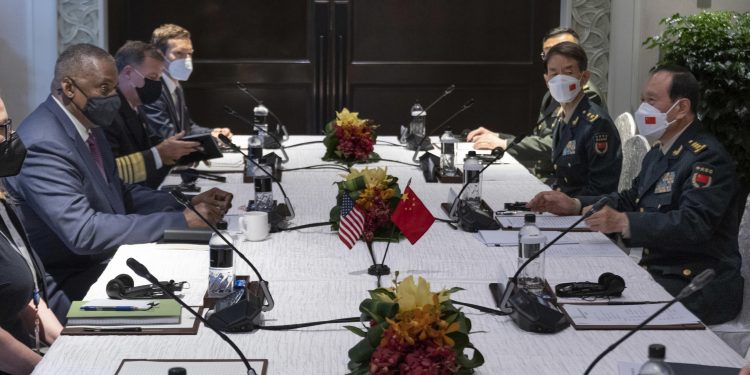The 2022 China Military Power Report lays out the challenges facing the United States military as it works to manage relations with the emerging superpower.
The report, released today, calls the Peoples’ Republic of China “the most consequential and systemic challenge to our national security and to a free and open international system.”
A senior defense official speaking on background said China is increasingly clear, in its ambitions and intentions. “It’s important to understand the contours of [Peoples’ Liberation Army] modernization to include their thinking about what the PLA’s way of war would look like, to kind of survey their current activities and modernizing capabilities and to assess their future military modernization goals,” he said to reporters prior to the release of the report.
The official said an important element of China’s strategy “is a determined pursuit to amass and expand its national power to transform — at least — aspects of the international system to make it more favorable to the PRC’s political system and its national interests.” This is a prime aspect of both domestic and foreign policy initiatives.
The official noted that as part of this, there is a trend of more coercive military behavior by China. “We’ve seen more coercive and aggressive actions in the Indo-Pacific region, including some of which we would highlight as being dangerous,” he said. This includes PLA ships and aircraft demonstrating unsafe and unprofessional behavior.
He noted that Secretary of Defense Lloyd J. Austin III specifically mentioned this in his meeting with his Chinese counterpart on the sidelines of the Association of Southeast Asian Nations Defense Ministers meeting in Cambodia last week.
Another element of China’s strategy is strengthening the PLA’s strategic deterrence capabilities. China defines this element broadly to include nuclear, space, cyber, electronic warfare, counterspace capabilities and more.
The official said the United States assesses that China has more than 400 operational nuclear warheads in its stockpile now. If this modernization effort continues, the Chinese could field about 1,500 warheads by 2035, he said.
The report also examines China’s “intensified” diplomatic, economic, political and military pressure against Taiwan. As part of this, the report also covers China’s efforts to conflate the U.S.’s One China Policy with the PRC’s own One China Principle. Chinese leaders do this to “erroneously portray broad international support for the PRC’s claims over Taiwan, and attempts to legitimize PRC coercive actions against Taiwan,” the official said.
The report is primarily a discussion of the military aspects of China, and it offers new insights on how the PLA views the future of warfare. “The PLA refers to ‘systems destruction warfare’ as the next way of war,” the official said. “They’ve also begun discussing a new operational concept for them: what they call a core operational concept … called multi-domain precision warfare.”
This new concept is intended to help identify key vulnerabilities in an adversary’s operational system, and then to launch precision strikes against those vulnerabilities, he said. These could be kinetic or non-kinetic. “Basically, it’s a way that they’re thinking about looking across domains to identify vulnerabilities in an adversary’s operational system and then to exploit those to cause its collapse,” the official said.
The report also addresses topics that illuminate the strategic thinking of Chinese leaders in strategic stability, China’s views on information and information dominance, and what the PLA is thinking about expanded military diplomacy, the official said.
One key theme is China “wants its economic and political and social and military and security developments to be coordinated and mutually reinforcing, and to support the ambitious objectives that Xi Jinping has laid out for national rejuvenation by 2049,” the official said. The report looks at China’s military modernization and defense strategy, but also looks at elements of China’s economic policy and foreign policy, “and how these all kind of fit together with the military and defense modernization in pursuit of its regional and global ambitions,” the official said.
Specifically, this addresses China’s military-civil fusion development strategy. The report says Beijing seeks to develop and acquire advanced dual-use technology for its military, while also serving a broader purpose to strengthen all of the PRC’s instruments of national power.
China is also growing its national industrial and technological base. “in terms of kind of broader defense ambitions, the PRC has a strategy that entails strengthening and adapting its armed forces to what it views as kind of long-term trends and global military affairs,” the official said. “As an outcome of the 20th Party Congress [in October], Beijing is focusing on intensifying and accelerating the PLA’s modernization goals over the next five years, including strengthening what they refer to as its system of strategic deterrence.”
The report details China’s regional and global ambitions. “As we noted in last year’s report, Xi Jinping and the PRC leadership are determined that the armed forces should take a more active role in advancing the PRC’s foreign policy goals globally,” the official said.
The Chinese military is pursuing overseas bases and logistics facilities. This would allow the PLA to project and sustain military power at much greater distances from its borders.
The report stresses that there is a potential for misunderstanding and miscalculation. “That kind of emphasizes the importance of effective and timely communications between the Department of Defense and the PLA,” the official said. “Strategic competition — even as strategic competition intensifies — doesn’t mean that confrontation or conflict is inevitable or unavoidable. And we’ve been clear that we’re committed to responsibly managing the competition with the PRC to try to ensure that it doesn’t veer into conflict unnecessarily.”











